Have your LED bulbs gone out, just when you were in the middle of completing an important task?
Didn’t you change them just recently?
Though you may not know what is causing the problem, there are a couple of reasons why your LED lights keep burning out before their time.
The most common reasons for LED blowing out are high voltage, bad contacts, or use of an incompatible dimmer switch. Other causes include overheating due to not using the right fixtures, or simply a bad batch of light bulbs!
In this article, I’ll take you through:
- The reasons your LEDs could be burning out
- Why LEDs might burn out in the same fixture
- Reasons new LED bulbs burn out quickly
- Whether you can fix a burned out light bulb
Table of Contents
6 Reasons Why Your LED Bulbs Keep Burning Out
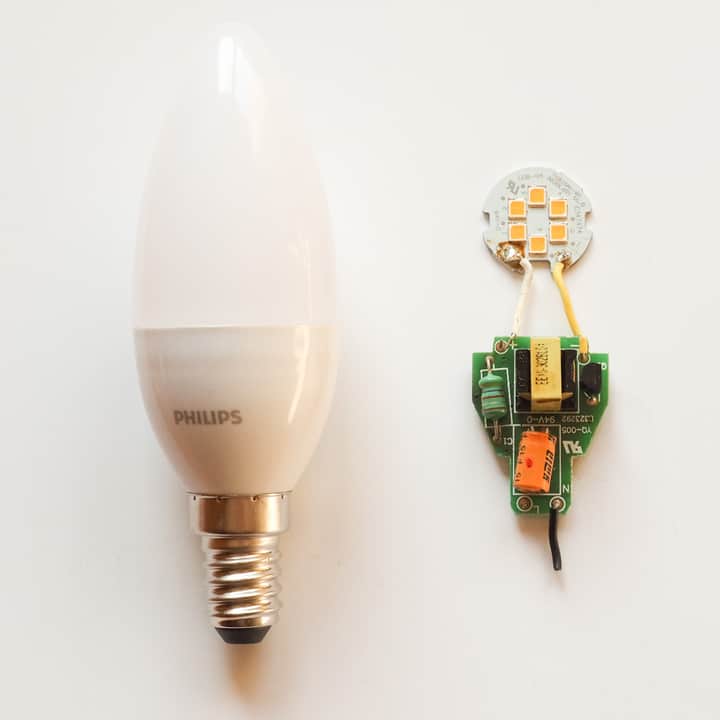
The potential reasons for an LED bulb burning out include:
- High voltage on the circuit
- Using incompatible LEDs on dimmer circuits
- Overheating
- Damaged lighting fixtures
- Incompatible lighting fixtures
- Loose wiring, or loose connections
High Voltage
One of the most common reasons is due to high voltage. If you have a high current running through your mains, this could easily be burning out your light bulbs.
LED lights are typically (but not always) designed for lower voltages – 12 volts or 24 volts.
And in a US home, your home circuits will run on 120 volts at 60 Hz. So something needs to step the voltage down to an appropriate level.
For mains-powered lights, that’ll be a transformer inside the plug. For light bulbs, there’ll be a driver inside the bulb casing doing that work.
But they are designed to step 120 volts down to 12v or 24v. If your home circuit is providing too many volts, they won’t work properly and your bulbs will burn out.
You can check your power outlets by using a multimeter:
- Turn the main power off and disconnect the outlet from the wiring.
- Set your multimeter to the voltage option and insert the short black lead into the jack labeled “-” or “COM.”
- Insert the red lead into the “+” or “OMEGA” jack.
- Remove the red and black leads, respectively.
- Connect the test leads to the circuit, black first and red second. Note the measurement to check it’s 120 volts.
- Remove the red lead first and the black lead second.
If the mains outlets are providing too many volts, or you’re concerned your lighting circuit is, you may want to hire your local electrician to come over and take a look. That’s a big job.
Dimmer Switches

Regular LED light bulbs aren’t designed to work with traditional dimmer switches. Normally they will either run too dim or flicker, but using an incompatible LED with a dimmer switch could cause it to burn out.
If you want the dimming effect, you need to find LED lights compatible with dimmers, and get a dimmer switch designed to work with LEDs.
Or, make things simpler by spending more on smart bulbs that can be dimmed without a special switch.
Overheating
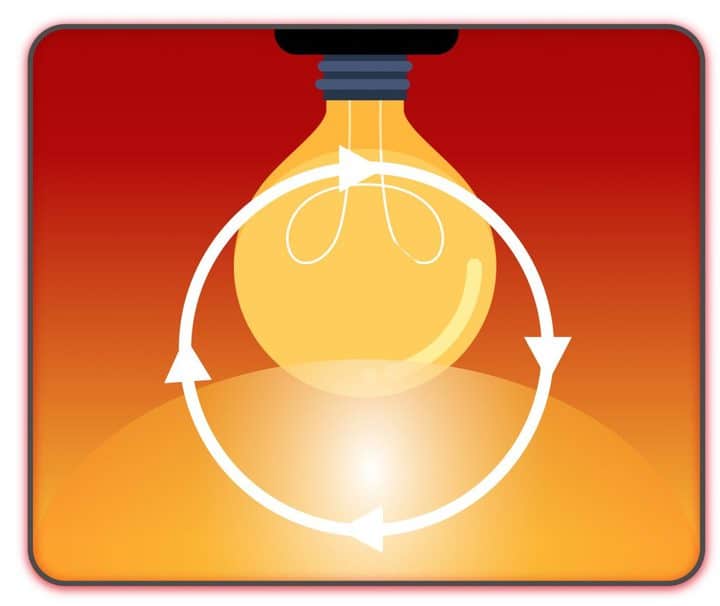
Overheating could be the cause of your LEDs burning out. LEDs are designed to work in low temperatures and so shorten their lifespan dramatically when they overheat. Potential overheating causes include:
- An inefficient heat sink
- A faulty LED driver
- Using a bulb where there is poor airflow
LED bulbs have to convert AC power to DC to work, but doing this generates heat.
This heat gets accumulated in the bulb’s tiny neck above the socket, and to dissipate that, LED bulbs have heat sinks.
Thus, an inefficient heat sink may cause the bulb to overheat – if it’s cheaply made, it won’t transfer the heat away fast enough.
Also, a lack of ‘current limiting’ causes overheating. A cheaply made light bulb might have poor quality drivers that don’t limit the current.
Avoid using LED bulbs in enclosed fixtures, unless they are rated to be used in one. This is another serial cause of overheating.
LED Light Bulbs Keep Burning Out In The Same Fixture
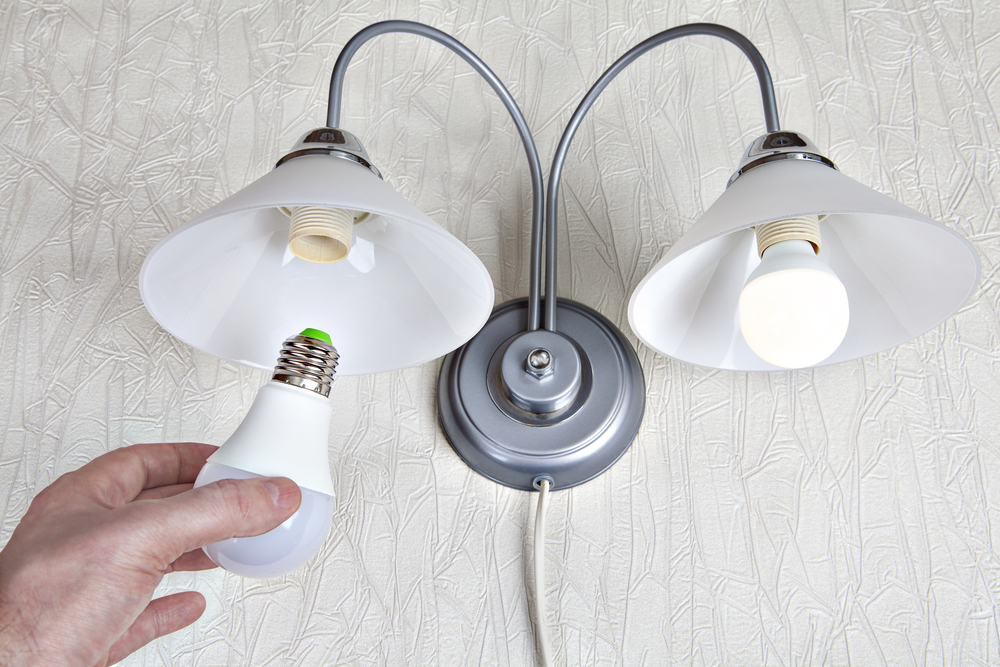
Sometimes you can damage a fixture if you’ve been screwing in the bulbs too tight.
This can result in damaging the socket tab.
To rectify, you can use pliers or tweezers to bend the tab slightly upwards, at about a 20-degree angle. Do this only when the power is off, of course!
Most fixtures are compatible with an LED light bulb, but again, if it’s enclosed, then it might not be. Some old fixtures reflect heat because they were originally designed for incandescent light bulbs. This would mainly be some older forms of recessed lighting like can lights.
If you’re swapping an incandescent bulb to an LED bulb, then you might damage it.
Finally, it may be that there’s just a loose connection between the bulb and the fixture, and that might be the bulb’s fault.
I’d recommend switching between brands to find the right bulb, as some bulbs just do not have enough solder at the bulb’s base for the bulb to connect with the socket tab.
The bulb solder and the tab should ideally be of the same size in order for a good connection to take place.
Why Do New LED Light Bulbs Burn Out Quickly?
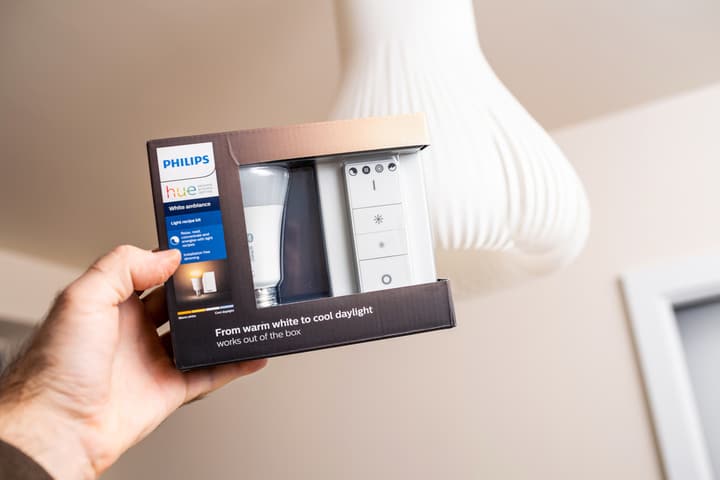
If a new bulb burns out immediately, it’s likely to be the fixture that has a problem. Check for corrosion or worn-out contact points, and replace the fixture if you spot them.
The corroded part, in most cases, can’t be repaired satisfactorily, and the same problem will arise again. So just buy a new one.
It may also be a loose electrical wiring connection to the light fixtures. To check:
- Switch off the power to the light fixture
- Remove the light fixture completely from the ceiling or wall
- Visually check the wiring connections
- Repair improper wiring and secure loose wires
- Use a voltmeter to help determine the problem
- Reinstall the light fixture and check with a different bulb
When you have checked the sockets, wiring connections, and everything else in your house, it may just be a bad light bulb.
How To Tell If LED Light Is Burnt Out?
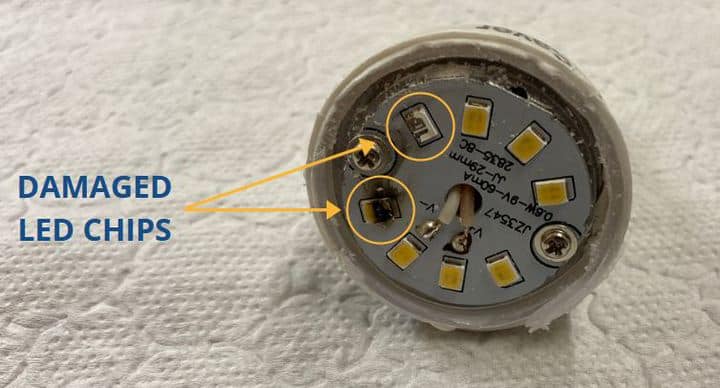
You can tell if an LED light is burned out because it won’t turn on, or it will but it will be very dim. LED bulbs don’t tend to have one light emitting diode inside, but multiple LEDs on the array. If only some of these diodes fail, the bulb may work, but it won’t be as bright.
That doesn’t mean that, if the light doesn’t turn on completely, all the diodes are dead. It could be one dead diode that is breaking the circuit and meaning that the others aren’t getting the current they need.
How To Fix A Burned LED Light Bulb?
To repair a burned out LED bulb:
- Remove the bulb from the fixture
- Take off the dissipator – the cover of the bulb – to reveal the circuit board with LED chips
- Using a multimeter, find the faulty LED
- Desolder the driver contacts and change the LED array
Alternatively, you can connect the contact pads instead of changing the damaged LED. If all the diodes are working, check the bulb cap for the bulb driver and conductors and discontinuity contacts.
With a multimeter, check the main components, change the capacitors that are not working, check the transistors and diodes for a shortage, and compare resistor values.
Also, check the voltage output on the IC chip of the driver.
Nowadays, you can also find LED bulb assembling kits and separate parts like the drivers, housings, PCBs with LEDs, and other components.
Now, if this all sounds beyond your ability or patience, you might just prefer to buy a new bulb. It’s not worth trying to get a licensed electrician to repair a bulb; they’ll just tell you to replace it.
Final Words
LED bulbs will last a lot longer than old incandescent bulbs, but that doesn’t mean they’ll always work forever.
But now you know the causes for bulbs burning out too quickly, you can try to prevent the issue in future.
And if your LEDs aren’t bright then there are fixes for that too.
Looking for an LED bulb but not sure what type you need?
Check out my free bulb picker and select the right bulb within few clicks.


Comments are closed.